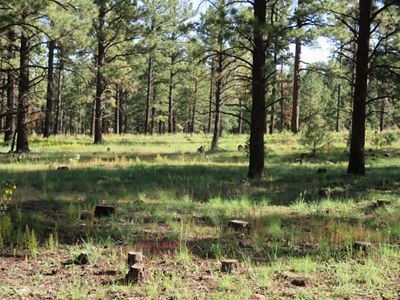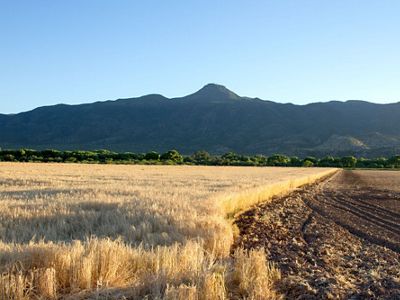Beer Comes from Forests
Beer has four main ingredients: water, grain, hops and yeast. While water may seem like beer’s simplest ingredient, there's a lot involved in getting that clean water to our taps.
Clean, plentiful water depends on healthy surrounding natural areas, like forests. From the tree canopy all the way down to root systems, every part of a forest plays a critical role in cleaning, storing and protecting our water supply.
Through OktoberForest, we're hoping to raise awareness about the important role forests play in providing clean water, a critical ingredient for quality beer. We're calling on beer lovers to help us protect beer's main ingredient.
Healthy Forests Are Essential for Abundant, Clean Water
Healthy forests allow more water to reach our underground aquifers and our streams and rivers. In Arizona and the Southwest, where extended drought and increasing demand are putting pressure on our limited water supplies, Arizona’s forests are clearly critical to our water future.
Years of fire suppression in our forests have created dense stands of small trees. After years of drought, these overgrown forests are at high risk of large, catastrophic mega-fires that put our communities and water supplies at risk. The small trees are like straws competing with each other to suck up precious groundwater. They also are like match sticks waiting to combust and flame the fires. Recent severe fires burned homes, forced evacuations, degraded water supplies, restricted recreation, forced wildlife relocations and caused damaging erosion.

The Urgent Need: Restoring Arizona’s Forests
The Nature Conservancy is a leading advocate of thinning our forests to restore a more natural, healthy balance and increase our water yield. Our research shows that forest thinning in the Salt and Verde River basins could yield substantially more water from the forest because there would be fewer trees competing for underground water. More underground water could mean more water for the streams and rivers, possibly offsetting water losses predicted from warming and drought conditions. Accelerated forest thinning would also reduce the risk of catastrophic forest fires that could befoul our streams and reservoirs with sediment and ash.

Water Benefits from Forest Thinning
Thinning, according to Nature Conservancy research, also benefits our headwater streams. That’s because more snowmelt soaks into the ground instead of evaporating on the tree canopy. Much of the water flowing in our forests, aquifers and streams is provided by melting snow in the high country. Overgrown forests use more water than healthy forests because excess trees act like straws all competing with each other for limited water. Thinning reduces competition for water. TNC research found that where forests are thinned, more water, potentially up to 20% more, is available to replenish aquifers and seep into streams in the upper watersheds. This additional runoff may help offset reduced stream flow due to drought and warming and reduce the impacts to native fish and other water-dependent natural resources.
For more information, see our Forest Resilience Fact Sheet.
Switching Crops to Protect Water
Another way to keep more water in our rivers and watersheds is to work with agriculture. In the Verde Valley, we are working with farmers and ranchers to improve their irrigation systems and reduce water waste. Another tactic is switching to crops that require less water, particularly in the drier months when flows are low.
Barley—used in cereals, baked goods and livestock feed—requires less water than traditional crops like corn and alfalfa. The peak water use for barley is in March, when the Verde River experiences peak flows. For corn and alfalfa, the peak water use is in June, when the river is most stressed and low flows fractionalize the habitat for fish and wildlife.

Launching Sinagua Malt
To encourage demand for barley, Chip Norton, Verde Conservation District Supervisor, and Kim Schonek, Verde River Project Manager at The Nature Conservancy, founded Sinagua Malt and invested in a four-ton barley malting tank. Stepping out of retirement, Chip borrowed from his savings to try something no one has ever done in Arizona—building a commercial malt house to support local breweries. It was a huge monetary investment and business risk, not to mention an overwhelming time commitment, but it has paid off.
To be successful, brewers had to be on board. It was critical that the flavor was spot on and people would buy Sinagua Malt’s product. When brewers gave the green light, Hauser & Hauser Farms upped the ante, moving from a pilot plot of 15 acres of malt barley to 150 acres of barley.
This move fundamentally changed the local agricultural market by creating a demand for malt barley and allowing farmers to successfully switch to growing barley crops. The change has kept tens of millions of gallons of water in the Verde River.
Cheers to That!
The Nature Conservancy provided project support throughout the transition from traditional crops of alfalfa and corn to barley. Now that Sinagua Malt is up and running full speed, it will be able to source grain from local farmers with payments that will match or exceed revenue from traditional crops.
Need a taste of the Verde Valley in your glass? Check out the following breweries where beer made with Sinagua base malt is available: Arizona Wilderness Brewing Co., Sedona Beer Co., Roses by the Stairs Brewing.
Want to Celebrate OktoberForest?
-

OktoberForest at Arizona Wilderness Brewing Co.
Save the Date: September 17, 2022. Enjoy live polka music, plus a special OktoberForest brew at Arizona Wilderness's Beer Garden at 201 E. Roosevelt St, downtown Phoenix.
If you like beer, you should love forests.
Beer is 95% water. And 40% of the world’s usable water comes from forests. Join The Nature Conservancy in our critically important effort to restore Arizona forests and secure our water future.
